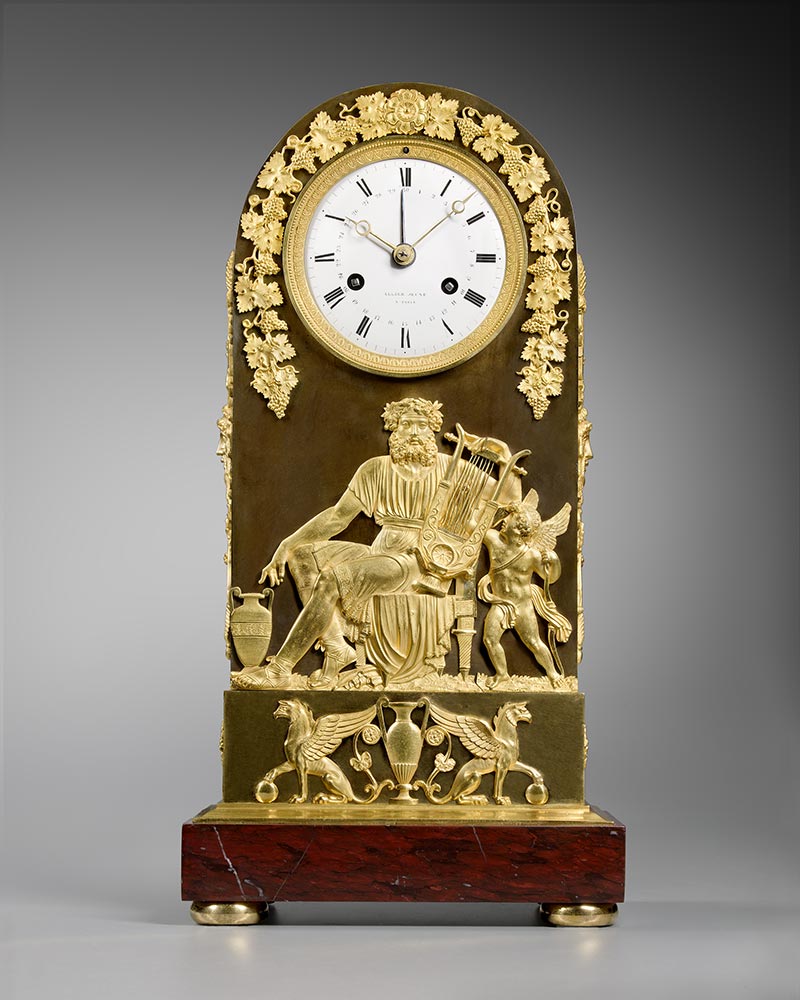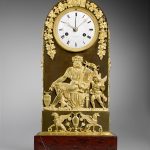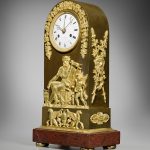A mantel clock representing Anacreon playing the lyre

Pendule ancienne
A Consulat gilt and patinated bronze and rouge griotte marble mantel clock
representing Anacreon playing the lyre,
the dial signed Allier Jeune à Paris – circa 1799-1804
Height: 45.7 cm. (18 in.) Width: 23.7 cm. (9 ¼ in.) Depth: 14.8 cm. (5 ¾ in.)
The enamel dial bearing the signature, with Roman numerals indicating the hours, gilt brass Breguet hands and a blued steel hand for the date. The circular movement has a recoil lever escapement and silk-thread suspension and strikes the hours and half-hours by means of a count wheel mounted on the back-plate.
Comparative Literature
Dictionnaire des Horlogers Français, Paris: Tardy, 1971.
Les pendules et bronzes entrés sous le Premier Empire, Musée national du Château de Fontainebleau, catalogue of the furniture collections, Paris, 1989, p. 77, nos. 42 and 43.
Two identical clocks are known:
- One signed Henry Lepaute à Paris, rue St Honoré 247, the base in Italian griotte marble, delivered by Lepaute uncle and nephew in August 1806 for the Prince’s Apartment, no. 8 in the Courtyard of Princes at the Palace of Fontainebleau (catalogue 1989, cit., no. 42).
- The other signed Bailly à Paris, the base in vert de mer marble, delivered in 1806 by Bailly to the salon of Antonio Aldini, Secretary of State to the Kingdom of Italy, at Fontainebleau (catalogue 1989, cit., no. 43).
Correspondence of the Gregorian and Republican calendars
The Republican calendar ran from 22 September to 21 September each year.
The year was divided into 12 equal months of 30 days each, plus 5 or 6 national holidays at the end of each year originally known as sans-culottides, renamed after 24 August 1794 as jours complémentaires (complementary days).
Each month was divided into three equal parts of 10 days called the first, second, and third décades.
The names of the days of each décade were: Primidi, Duodi, Tridi, Quartidi, Quintidi, Sextidi, Septidi, Octidi, Nonidi, Décadi.
The names of the months were:
For Autumn: Vendémiaire, Brumaire, Frimaire.
For Winter: Nivôse, Pluviôse, Ventôse.
For Spring: Germinal, Floréal, Prairial.
For Summer: Messidor, Thermidor, Fructidor.
Year II began on 22 September 1793; Year XV began on 22 September 1806. In practice, the use of this calendar ceased on 1 January 1806. However, one can still indicate 1807 as Year XVI and 1808 as Year XVII (see Tardy, op. cit., 1971).


